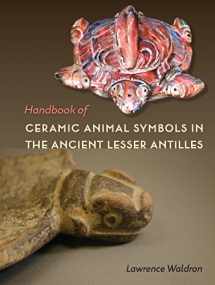
Handbook of Ceramic Animal Symbols in the Ancient Lesser Antilles (Florida Museum of Natural History: Ripley P. Bullen Series)
Book details
Summary
Description
"This study offers a fascinating insight into the animal symbolism intertwined with the religious beliefs of the pre-Columbian inhabitants of the West Indies. It is a true Amerindian bestiary, illustrating the profound relationship between the Antillean zoomorphic iconology and the ideas, mythic traditions, and ideology behind them."--Arie Boomert, coauthor of The 1946 and 1953 Yale University Excavations in Trinidad
"Waldron’s work adds to our understanding of a people and culture lost to time. It provides a practical understanding of their symbols and information about their environment, the creatures of their world, and places of origins and myths. It also raises ceramic analysis to a higher level of meaning, reminding us of the diversity of symbolisms embedded in pottery as a medium of artistic expression."--Reginald Murphy, Director of Heritage Resources, National Parks Antigua
The importance of animals as surrogates and signifiers in pre-Columbian art places them at the foundation of symbolic language and visual culture throughout much of the ancient Americas. However, with no comprehensive iconographic study of the ceramics of the Lesser Antilles, it has fallen to archaeologists, anthropologists, historians, linguists, and art historians to independently decipher the many species and symbols as they seek interpretations of visual culture in the archaeological record.
In this volume, Lawrence Waldron surveys zoomorphic iconography from over twenty major international collections, focusing on the cultural significance of nearly two dozen representations found in Saladoidera ceramics. He provides criteria for systematically identifying each recognizable species and then explores the modeled and painted imagery of terrestrial and aquatic mammals, bats, birds, reptiles, and amphibians. Each chapter is divided into sections dedicated to individual species, and Waldron explores the traditional narratives and other folk traditions associated with the species, as well as the frequency with which the representations of the species appear across the Caribbean. He also tracks the iconographic and stylistic differences between the various islands, cross-referencing these differences with ethnographic accounts of regional cohesion, schism, and migration among South American populations. Waldron shows how these regional disparities may have been politically savvy expressions of cultural distinctions among emergent Caribbean subgroups. Unique iconographic interests and emphases, especially in the imagery of owls and some aquatic species, suggest that sociopolitical, spiritual, and iconological differences may have even motivated migration into the Caribbean islands after which these differences were stressed and elaborated as aspects of new regional identities.
A volume in the Florida Museum of Natural History: Ripley P. Bullen Series


We would LOVE it if you could help us and other readers by reviewing the book
Book review



